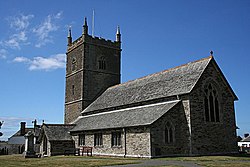St Issey
| St Issey Cornish: Egloskrug | |
| Cornwall | |
|---|---|
 St Issey Church | |
| Location | |
| Grid reference: | SW928718 |
| Location: | 50°30’36"N, 4°55’23"W |
| Data | |
| Post town: | Wadebridge |
| Postcode: | PL27 |
| Dialling code: | 01841 |
| Local Government | |
| Council: | Cornwall |
| Parliamentary constituency: |
North Cornwall |
St Issey is a village in Cornwall, about two miles south of Padstow. The wider St Issey parish covers an area of approximately 4,500 acres. At the 2011 census the parish population was recorded as 940.
The village is a small place, with a 15th century church and close by it a pub, the Ring O Bells Inn, known locally as 'The Ringers". Dating from the 17th century it is one of the oldest inns in the area and still retains many of its original features.
History
The parish takes its name from Saint Yse (or Ida), one of the twenty-four children of St Brychan, a 4th-century Welsh saint and king. (The name of the hamlet St Jidgey is also derived from the name of the same saint.)[1] The Cornish name means "the church on the tumulus". In early records Egloscruk is the name of the parish, while St Ida refers to the site of the saint's chapel and holy well at Zanzidgie.
Until 1199 the parish formed part of the manor and peculiar of Pawton, belonging to the Bishop of Exeter; it was then appropriated by the bishop to the Chapter of Exeter Cathedral.[2] At Sea Mills near Trevorrick are the remains of a sea mill, driven by the tide, on the River Camel.[3]
Parish Church
The parish church is partly Norman and was enlarged in the 15th century when the south aisle and tower were built. The tower has been rebuilt twice, ca. 1680, and again in 1871. In 1869 the church tower was struck by lightning and collapsed.[4]
Though there was a "lamentable rebuilding in 1871" (Charles Henderson) there are some features of great interest. These include the reredos and a Pietà of Catacleuse stone which may be fragments of a late mediæval monument, possibly that of Lady Matilda Chyverston which is mentioned in a document of 1399. According to local tradition the stonework was originally in the chapel at Halwyn, an estate of the Hamelys. Ruins of the house, chapel and columbarium were mentioned by Henderson in 1925.[5]
Trelow Downs
Trelow Downs, to the south of the civil parish, is designated as a Site of Special Scientific Interest for the dry and wet heaths, valley mires and scrub.[6]
Outside links
| ("Wikimedia Commons" has material about St Issey) |
References
- ↑ Weatherhill, Craig (2009). A Concise Dictionary of Cornish Place-Names. Westport, Co. Mayo: Evertype. ISBN 9781904808220; p. 63
- ↑ Cornish Church Guide (1925) Truro: Blackford; pp. 110-11
- ↑ Tidemills
- ↑ The Illustrated London News; Vol. LIV
- ↑ Cornish Church Guide (1925) Truro: Blackford; pp. 110-11
- ↑ SSSI listing and designation for Trelow Downs
